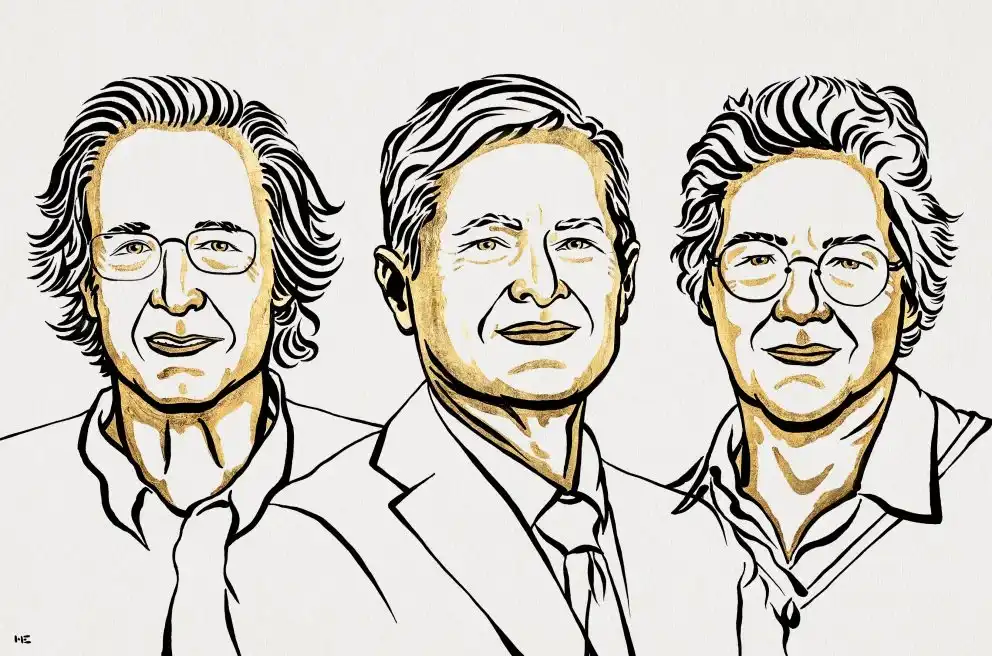Nobel Prize in Physics Awarded for Techniques to Produce Ultrashort Pulses of Light
Three scientists have received the prize for experimental work that allows researchers to probe the dynamics of electrons in atoms and molecules
October 3, 2023 — The Royal Swedish Academy of Sciences has awarded the 2023 Nobel Prize in Physics to Pierre Agostini, Ferenc Krausz, and Anne L’Huillier for “experimental methods that generate attosecond pulses of light for the study of electron dynamics in matter.”
“The American Physical Society congratulates the 2023 physics laureates for their pioneering discoveries that paved the way for attosecond physics,” said Jonathan Bagger, CEO of APS.

Credit: Ill. Niklas Elmehed © Nobel Prize Outreach
The Nobel Committee for Physics has split the prize equally among the three laureates: Agostini of Ohio State University in the United States, Krausz of the Max Planck Institute of Quantum Optics and Ludwig Maximilian University of Munich in Germany, and L’Huillier of Lund University in Sweden. The three physicists developed techniques to produce extremely short pulses of light that can be used to probe the minute dynamics of electrons in atoms and molecules.
“The laureates’ achievements really get to the heart of what physics is about — understanding how the world works on extremely short time scales,” said Robert Rosner, president of APS. “It’s excellent experimental work that opened doors to new applications as well as furthered our fundamental understanding of matter.”
The behavior of electrons can change on short notice — as short as a few tenths of an attosecond. An attosecond is 1 x 10-18 second, or one billionth of a billionth of a second. The number of attoseconds in one second is roughly the same as the number of seconds since the start of the universe. Attosecond physics uses light pulses that last for as short as a few hundred attoseconds to study the interactions of light and matter on tiny scales.
The laureates’ contributions to techniques for producing attosecond light pulses have allowed researchers to examine ultrafast electron behaviors that couldn’t be studied before. In the future, attosecond physics could give rise to applications such as producing very fast electronics, by allowing a material to switch from being an insulator to a conductor extremely quickly, and detecting early signs of disease in a biological sample, by looking for changes in the sample at high time precision.
All three laureates have published work in APS’s Physical Review journals. L’Huillier is an APS member and an APS Fellow and has been recognized by APS’s Outstanding Referees program.
The Nobel Committee has cited five papers from Physical Review Letters and one paper from Physical Review A in the scientific background on the 2023 physics prize. This marks the 13th consecutive year that the Nobel Committee has cited laureates’ papers in the Physical Review journals as central to the physics or chemistry awards.
The Nobel Prize is often regarded as the highest honor in science. The prize includes 11 million Swedish kronor, about 1 million US dollars, that will be shared equally among the three recipients.
The following Physical Review Letters and Physical Review A articles, cited in the scientific background on the Nobel Prize in Physics 2023, are free to read:
APS Press Releases
APS issues press releases on research news, Society activities, and other physics tips.
APS Media Contacts
General Media Inquiries
media@aps.org
Using the APS Logo
About APS
The American Physical Society is a nonprofit membership organization working to advance and diffuse the knowledge of physics through its outstanding research journals, scientific meetings, and education, outreach, advocacy, and international activities. APS represents more than 50,000 members, including physicists in academia, national laboratories, and industry in the United States and throughout the world.
